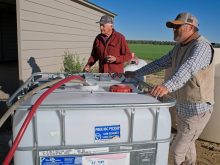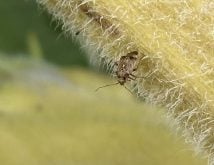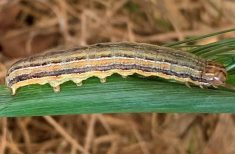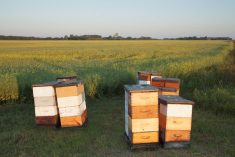Resistance to insecticides is complicating pest control for potato growers, with experts warning that overuse, off-target exposure and pest resurgence are driving control failures.
At Manitoba Potato Days in Brandon in late January, Ian MacRae, an entomologist with the University of Minnesota’s Northwest Research and Outreach Center, spoke about the mechanisms behind insecticide resistance and the growing challenges it presents.
Field bioassays conducted in 2017 found soybean aphid populations at Portage la Prairie, Carman, and Winkler were already resistant to synthetic pyrethroids, which are derived from the natural pyrethrins found in chrysanthemum flowers. With the aphids able to produce seven to eight generations a year, the repeated use of the same mode of action has only accelerated resistance.
Read Also

Hemp’s future hinges on honest agronomy, experts say
Years of hype have given way to a more realistic view of hemp. Canadian farmers and processors say its future depends on solid agronomy and honest messaging.
Two-spotted spider mites have also developed resistance in some regions. Populations from western Minnesota and eastern North Dakota were found to be resistant to chlorpyrifos, also known as chlorpyrifos ethyl.
“Pyrethroids are not recommended for controlling these mites due to a phenomenon known as hormoligosis, where sublethal exposure to pesticides can actually increase reproduction rates,” MacRae says.

Resistance arises through a combination of genetic and environmental factors, he says. Some insects carry pre-existing genetic traits that make them less susceptible to insecticides. These traits are often rare in a population, but with repeated exposure to a chemical, resistant individuals survive and pass those traits on to future generations.
Several mechanisms allow insects to survive pesticide applications, such as metabolic resistance, in which the pest detoxifies the insecticide faster than a susceptible individual, and target-site resistance, in which the receptor sites affected by the pesticide are altered.
Some pests also develop penetration resistance, which slows down absorption of the chemical, giving their detoxification systems more time to neutralize the toxin. Others exhibit behavioural resistance, actively avoiding treated areas or emerging later in the season when pesticide residues have faded.
Predictable patterns changing
For Colorado potato beetles, one of the most problematic pests, behavioural resistance has made control increasingly difficult. In many areas, these beetles have begun emerging later in the season, avoiding at-plant applications of neonicotinoid insecticides, MacRae says.
“It used to be we’d have adults entering the field in the spring, maybe just a little bit, then they’d mate, have offspring with a big, heavy defoliator early in the season, those June, early July periods. And after mating and having eggs, the overwintering adults usually would just kind of die off. And so, you’d have this big peak of defoliation early in the season from the larva they eat, and then when they were finished growing, they’d drop to the ground, off the plant, burrow into the soil, and then they pupate down there and change into adults.”
This predictable pattern of emergence is now changing, with adult beetles, larvae and eggs appearing at the same time in July, overlapping in a way that makes control efforts more difficult, MacRae adds, noting this information comes from entomologists at the University of Wisconsin and Michigan State University.
The delay in emergence has serious implications for pest control strategies. Typically, early-season neonicotinoid applications target overwintering beetles, but with later-emerging populations, the insecticide concentrations in plants are too low to be effective. This allows susceptible beetles to avoid exposure and survive, leading to an increase in resistant individuals.
“The later emergence of a large portion of population actually are susceptible to neonicotinoids. They’re not the resistant ones. The resistant ones come out and they don’t care. They’ll feed on it anyway, because they can detoxify basically a lot of their resistance,” MacRae says.

Resistance is not just a problem of the past, MacRae says. In 2023, roughly 70 per cent of all global insecticide sales came from just four modes of action, increasing the risk that pests will continue to develop cross-resistance to multiple chemicals.
Cross-resistance occurs when an insect develops resistance to one insecticide but also becomes less susceptible to another, even if it has never been exposed to it. Growers who rely on rotation strategies could be affected by this, as resistance to one chemical could render an entire class of insecticides ineffective. Behavioural resistance is also playing a growing role, MacRae says.
“This is where… it allows the insect to escape or avoid the insecticide application.”
Newer insecticides have been developed to target specific life stages of pests, such as early instar larvae — but even these approaches are not foolproof, MacRae says. In Michigan, Wisconsin and Minnesota, Colorado potato beetles have exhibited behavioural resistance by remaining in diapause, a hibernation-like state, longer, emerging only after the insecticide residues in plants have diminished.
The economic challenges of insecticide resistance also cannot be ignored, MacRae says. The cost of developing a new insecticide is extraordinarily high.
“Back in 2011, when they did a large study, a consulting company looked at the cost of developing a molecule… that might have insecticide potential, it was a 10-year process, and it cost $250 million,” he says, adding that the cost now be well over $300 million.
There are steps growers can take to slow the development of resistance, MacRae says. He recommends rotating modes of action whenever possible and avoiding back-to-back applications of the same class of insecticide across successive generations of a pest.
Reducing off-target applications can also help, as can targeting treatments in both space and time to ensure maximum effectiveness.
While not all application failures are due to resistance, it’s important to recognize the warning signs and adjust management strategies accordingly, MacRae says.
With resistance already widespread in several key pest species, growers are being urged to adopt integrated pest management practices that rely on a combination of cultural, biological, and chemical controls.
Without changes to current approaches, experts like MacRae warn that growers could soon face a future with fewer viable options for managing potato pests.
















